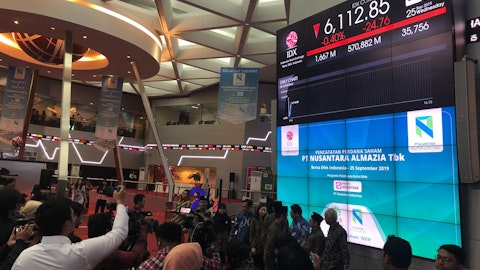Solmaz Altin: Thank you very much. So first of all, we grew health 20% in 2023 from about $280 million to $330 million. And we have set out in our health strategy explanation in August that we’re going to plan to double that by 2027. And we’re doing this by primarily tackling two strategic legs. One is really managing health business as it deserves to be managed, not just as an attachment to a life chassis, but really as a standalone business. Looking at metrics that matter for health business that do not necessarily matter for life business like combined ratio, loss ratios. Focusing on the eminent core value chain of the health business like underwriting, pricing, claims management. With that, and as Ben alluded to as well, we can save hard dollars and just get more profitability of our existing business.
Secondly, we’re certainly going to look at new value propositions of standalone health medical reimbursement products, medical ICI products and the like, where we see a really big need in health protection gap in many of our markets. Thirdly, as we’re building up capabilities at the center and in the countries with regards to managing the health book better and more profitably, let me remind you as Anil said, 90% of our business currently is coming from the four countries, Hong Kong, Singapore, Malaysia, Indonesia. Just with these four countries, we have a significant potential to increase our value propositions and grow, and at the same time work in our existing business to make it more profitable. On top of that, countries like Thailand, Philippines, Vietnam, highly populated countries, hundreds of millions of individuals with a high protection gap in health, are just making up 10% of our book currently.
So there’s ample room to grow, and we will certainly, as Anil said, we’ll not hold back in exceeding that target by 2027. But as of now, we are continuing to execute on the new operating plan, and we will continue to update as we move forward in the quarters.
Anil Wadhwani: Thanks, Solmaz. And just one other call out in terms of India. We do have the opportunity, as we’ve kind of illustrated earlier, to be able to set up our health business, which we are actively again looking at, which we can outside the joint venture that we have with ICICI. And again, India is a huge opportunity when we think about it in terms of the health business.
Patrick Bowes: Thanks, Anil. I think we’ll go back to the phones. I’m just conscious of time, so if we can have quick questions, and then there will be more people who get charged. So can we go back to the phones, Sebastian?
Operator: Of course. Next question is from Kailesh Mistry from HSBC. Please go ahead.
Kailesh Mistry: Hi, good afternoon. Thank you for taking my questions. Three from me. First one is just going back to cash remittances. Ben indicated in his speech that the remittance ratio is around 80% in 2023 versus a medium-term average in the 60s. What should we expect this to be going forward? Secondly, just to recap on investment spend, you said that there’s $900 million left, which will be split in 2024 and 2025. How much of that will go through the P&L and the cash numbers? Thirdly, just coming back to Hong Kong, you talked about improving sales mix through the course of 2023. Has this continued in terms of sales mix improvement in the first couple of months? On the top-hand right side of that chart, slide 26, I think, you talked about the H&P contribution as a policy count basis.
What is that in MBV and AP terms? Then if you could just give us a little bit more color on Hong Kong MCV. I think Anil mentioned 70% of business comes from new customers. What proportion comes from non-GBA? What is the growth in the MCV focus agents? Thank you.
Anil Wadhwani: Thank you, Kailesh. I’m going to first ask Ben to address the cash remittance and the $900 million spend and how we’ll be thinking about that. Then I will turn to Lilian to speak to specifically the H&P mix in terms of its contribution to MBP and the GBA versus non-GBA. Ben, you want to?
Ben Bulmer: Yeah, thanks. I’ll be a bit quicker in my answers this time. Hi, Kailash. Thanks for the question. In terms of the remaining $900 million, I’d guide you to around $250 million, $300 million this year, similar number in 2025, still weighted towards the beginning of the objective period. Split again, stick to the rule of thumb I gave, I think back in August, roughly two thirds CSM, one third P&L. In terms of your cash remittance ratio question, yeah, you’re right. So we were slightly higher in 2023 at 80 versus the 60 kind of average over the last five years. There’s an element of bringing up more to pay down the debt that matured. I’d look to this year as just a very rough rule of thumb, around 70%. But as I said, we’re actively looking at sort of uses of capital, the capital in the businesses.
And I do need to balance this, of course, against that sort of nimbleness of having that capital in country. And also satisfying local stakeholders, regulators, distribution partners, rating agencies and so on. So, yeah.
Anil Wadhwani: Thanks, Ben. Thanks for that. Lilian, you want to take those two questions on sales mix and the GBA versus non-GBA?
Lilian Ng: Okay. On the HMP, contribution to MPP in 2023 is actually 40% in terms of MPP contribution. So on MCV of the MCV customers, about a third comes from GBA cities. The rest actually come from mostly tier one cities such as Beijing, Shanghai, Zhejiang, and etc. In terms of our recruitment on agency, our MCV agents in the past, you’ve heard us spoke about recruiting from what we call the IAMG, who are the graduates in Hong Kong. And we continue to do that. And what we’ve actually embarked on in 2023 is also we could MCV agents from the talent scheme, which the Hong Kong government has actually promoted in 2023. And that is actually driven up our increasing MCV agents in 2023.




